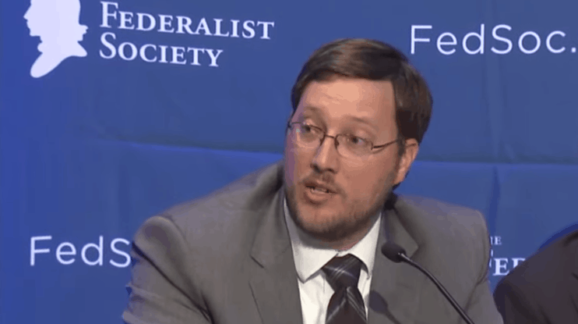VIDEO: Report Card on Regulatory Reform

Earlier this week I had the good fortune to spend some time at the historic Mayflower hotel here in Washington, D.C. attending the Federalist Society’s 7th Annual Executive Branch Review conference. Organizers had assembled an impressive array of government officials and legal experts to present on and debate the state of the nation’s Article II governance.
The weighty first panel (video above) featured four general counsels and one deputy general counsel of various cabinet departments and independent agencies, moderated by George Mason University’s Adam White. They each had good examples to give of deregulatory work their departments and agencies have been doing, and how they’ve been complying with the “1-in, 2-out” and zero regulatory budget provisions of executive order 13771.
As my colleague Wayne Crews pointed out at Forbes toward the end of last year, the administration has been exceeding its goals in this area:
While a dollar amount for cost savings of some $10 or $11 billion (in present value terms) was anticipated for fiscal year 2018, the White House says $23 billion was cut.
The rules-out to rules-in ratio for significant regulatory actions was four-to-one, with 14 significant new regulatory actions and 57 significant deregulatory ones. This is compared to 22-to-one last year (December 2017), when three new regulatory actions were imposed while 67 deregulatory actions were taken. Some of the 2017 repeals were of Obama-era regulations via the Congressional Review Act; signed into law by Trump, boosts not entirely available in 2018.
We also heard about the walk-back or withdrawal of inherited Obama-era rules. The Department of Agriculture’s Stephen Vaden gave a blow-by-blow account of how incoming administration officials dealt with the Organic Livestock and Poultry Practices rule, which would have further regulated how animals, which are destined to be sold in meat products as organically raised, are housed and transported. Vaden explains how previous analysis had misstated the cost/benefit balance of the rule by applying the incorrect discount rate to the value of future benefits. More fundamentally, he emphasized that a fresh look at the relevant statute didn’t justify the department undertaking this rulemaking in the first place. As the department stated in March 2018:
Significant policy and legal issues were identified after the rule published in January 2017. After careful review and two rounds of public comment, USDA has determined that the rule exceeds the Department’s statutory authority, and that the changes to the existing organic regulations could have a negative effect on voluntary participation in the National Organic Program, including real costs for producers and consumers.
“The existing robust organic livestock and poultry regulations are effective,” said USDA Marketing and Regulatory Program Undersecretary Greg Ibach. “The organic industry’s continued growth domestically and globally shows that consumers trust the current approach that balances consumer expectations and the needs of organic producers and handlers.”
Environmental Protection Agency General Counsel Matthew Leopold addressed a few of the administration’s marquee energy and land use initiatives, chiefly the Affordable Clean Energy (ACE) rule, the Safer Affordable Fuel Efficient (SAFE) Vehicles rule, and the revisions to the Waters of the United States rule. He emphasized that, in these proceedings, the EPA was seeking a reasonable rebalancing of costs and benefits while maintaining the agency’s statutory requirements to protect air, water, and land resources. The ACE rule, for example, is the successor to the Obama administration’s Clean Power Plan, and features a number of advantages, including not violating the traditional joint authority of states and the federal government over energy production and utility regulation decisions. The SAFE Vehicles rule, which altered federal mileage requirements for new cars, happily addresses safety concerns that CEI has been warning about for decades, and will yield cars and trucks that are both safer and more affordable in future model years. The new rule will also not, as some critics have claimed, lead to increased health risks from tailpipe emissions.
The senior officials that White wrangled on his opening panel were upbeat and concise about where they and their colleagues are heading, and how they plan to continue advancing the regulatory reform agenda. They explained how their actions over the past two years have been advancing the goals of broadly-written executive orders like 13771 (“Reducing Regulation and Controlling Regulatory Costs”) and 13777 (“Enforcing the Regulatory Reform Agenda”), but also issue-specific ones like 13868 (“Promoting Energy Infrastructure and Economic Growth”) and 13855 (“Promoting Active Management of America’s Forests, Rangelands, and Other Federal Lands”).
Hopefully they’ll have even more impressive results to report next year. See the full list of video coverage of the Federalist Society’s Executive Branch Review conference on YouTube:
- Address by Mick Mulvaney
- Panel: “How the Federal Government Litigates Cases”
- Panel: “Corporate Responsibility: Maximizing Shareholder Benefit v. Social Justice”
- Panel: “Division of Authority: DOJ Antitrust; the FTC; the FCC; USPTO”
- Lunch: “Revisiting Judicial Deference”
- Panel: “Alphabet Soup: EEOC v. OCR v. DOL OFCCP”
- Panel: “The Trump Administration’s Proposed Redefinition of “Navigable Waters” – Too Much, Too Little, or Just Right?”
- Address by Vice President Mike Pence